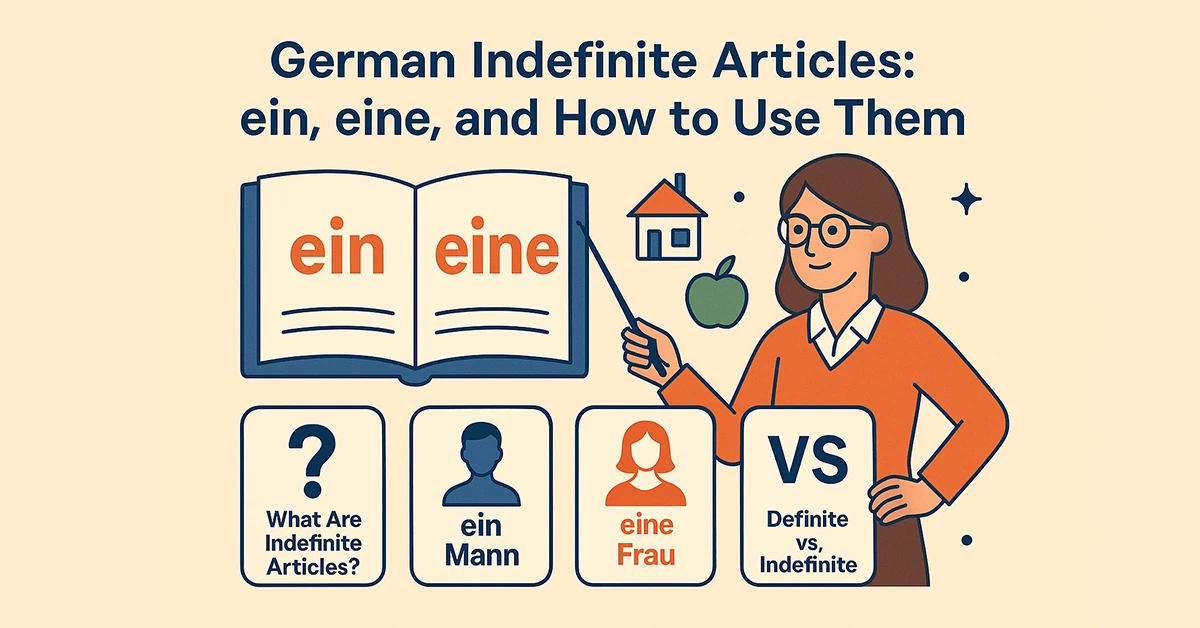German Indefinite Articles: ein, eine, and How to Use Them

Learn how to use the indefinite articles ein and eine in German. Grammar rules, gender, and examples included for beginners.
What Are Indefinite Articles in German?
Indefinite articles are used to refer to nonspecific nouns. In German, they are “ein” and “eine”, similar to “a” and “an” in English.
Why Indefinite Articles Matter in German Grammar
Understanding how to use “ein” and “eine” is essential because they help define the gender and number of a noun — something crucial in German grammar.
When to Use “ein,” “eine,” and “ein”
- ein – masculine or neuter (e.g., ein Mann, ein Kind)
- eine – feminine (e.g., eine Frau)
- ein – reused for neuter nouns (e.g., ein Auto)
Gender and the Indefinite Article
Each German noun has a gender: masculine, feminine, or neuter. The gender determines whether you use “ein” or “eine”.
How to Recognize the Gender of German Nouns
Many word endings hint at gender. For example: “-ung” is usually feminine, “-chen” is neuter, and “-er” is often masculine.
Indefinite Articles by Case in German
Articles change depending on the case: nominative, accusative, dative, or genitive. Let’s explore them one by one.
Tables: Declension of ein and eine in All Four Cases
| Case | Masculine | Feminine | Neuter |
|---|---|---|---|
| Nominative | ein Mann | eine Frau | ein Kind |
| Accusative | einen Mann | eine Frau | ein Kind |
| Dative | einem Mann | einer Frau | einem Kind |
| Genitive | eines Mannes | einer Frau | eines Kindes |
Visual Summary: The Indefinite Article Chart
Use a colorful chart to remember the article endings. Visual memory helps reinforce grammar patterns more effectively.
Examples of Indefinite Articles in Real Sentences
- Ich habe ein Buch.
- Sie sucht eine Wohnung.
- Wir sehen einen Hund im Park.
How to Choose Between ein and eine
Always ask yourself: What is the gender of the noun? What case is being used? The answers guide your article choice.
How to Use kein/keine as Negative Articles
To negate a noun, use kein/keine instead of nicht + noun. Example: “Ich habe keine Zeit.”
Indefinite Articles vs. Definite Articles
“Ein/eine” (a/an) are used for general items, while “der/die/das” (the) are for specific things already known to the speaker and listener.
Indefinite Articles with Adjectives: ein guter Mann
When adding adjectives, the endings of the adjectives also change depending on gender, case, and article. Example: “ein guter Mann”, “eine kleine Stadt”.
Using Indefinite Articles in Questions
- Hast du eine Idee?
- Gibt es einen Supermarkt in der Nähe?
How Word Order Affects the Indefinite Article
Word order itself doesn’t change the article form, but knowing the position of subject and object helps determine the correct case — which affects the article.
Common Mistakes and How to Avoid Them
- Using “ein” for feminine nouns (should be “eine”)
- Forgetting to change the article in accusative/dative cases
- Confusing “kein” and “nicht”
Tips to Learn ein and eine Faster
- Use flashcards with pictures and gender colors
- Label items at home with articles
- Group nouns by gender when studying
Practice Time: Test Yourself on ein/eine
Try filling in the blanks:
- Ich kaufe ___ Apfel.
- Sie braucht ___ Tasche.
- Wir sehen ___ Haus.
Conclusion: Learn to Use Indefinite Articles Confidently
Mastering “ein” and “eine” is key to building sentences. Keep practicing with examples and pay attention to gender and case patterns.
FAQ About German Indefinite Articles
Is “ein” used for both masculine and neuter?
Yes. “Ein” is used for both masculine and neuter nouns in nominative case.
What’s the plural of “ein” or “eine”?
There is no plural form of indefinite articles in German. Instead, use “keine” or just the noun.
How do I know the noun’s gender?
Use dictionaries, memorize common endings, and practice with categorized word lists.